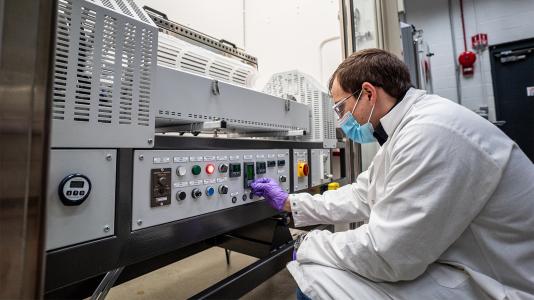A new paradigm for battery recycling
Argonne forges collaboration with Toyota to make the U.S. more competitive globally in battery recycling

For a successful clean energy transition in the U.S., the production of electric vehicle (EV) batteries must grow substantially. But the U.S. relies heavily on other countries for these materials and is vulnerable to supply chain disruptions.
The U.S. Department of Energy’s (DOE) Argonne National Laboratory has recently launched a collaboration with Toyota Motor North America that could reduce the nation’s reliance on foreign sources of battery materials.
“Direct recycling is cutting-edge in the battery industry. There are a few startup companies with small-scale pilot projects underway. But implementation at commercial scale is still in need of new innovations.” — Argonne Principal Materials Scientist Albert Lipson
Argonne, Toyota Research Institute of North America and Toyota’s Battery Lifecycle Solutions group are exploring an innovative approach to recycling battery components. If successful, this effort can make domestic battery supply chains more robust and circular. That in turn can enable rapid deployment of EVs in the U.S.
A cheaper, less wasteful recycling process
In most battery recycling today, the chemical structure of end-of-life battery components is broken down into the raw materials used in manufacturing. Unlike this traditional approach, a technique called direct recycling carefully extracts components from spent batteries. The components’ original structure is retained. If done well, manufacturers can re-use the components.
How can direct recycling help domestic material supply chains? The cathodes (positive electrodes) in batteries have complex chemistries. As a result, their manufacturing processes are costly and produce a lot of waste. By preserving the cathodes from end-of-life batteries, direct recycling can significantly reduce manufacturing costs and waste. It can also reduce the need for pristine raw materials.
“Direct recycling is cutting-edge in the battery industry,” said Argonne Principal Materials Scientist Albert Lipson. “There are a few startup companies with small-scale pilot projects underway. But implementation at commercial scale is still in need of new innovations.”
Applying Argonne’s direct recycling process to Toyota’s batteries
Argonne and Toyota Motor North America have signed a Cooperative Research and Development Agreement to develop a direct recycling process for cathodes in lithium-ion batteries, which are prevalent in EVs. In particular, the team is looking at cathodes made of nickel, manganese and cobalt.
The collaboration is taking advantage of an effective, patent-pending direct recycling process developed by the Argonne-based ReCell Center. The process uses a magnet to separate cathodes and anodes (negative electrodes) from batteries.
Toyota is providing Argonne with both end-of-life and new Toyota plug-in hybrid EV batteries.
“Besides recycling end-of-life batteries, we’re also interested in recycling new batteries,” said Lipson. “Manufacturers produce some battery cells that fail quality testing. We can potentially demonstrate that manufacturers can take cathodes out of failed cells and put them back into their production process. This capability could translate into huge cost savings.”
Researchers at Argonne’s Materials Engineering Research Facility (MERF) will apply ReCell’s direct recycling process to Toyota’s battery cells, extracting and regenerating the cathode material. The team will test various aspects of the cathodes’ performance — such as their capacity, lifetime and impedance (a type of resistance to electric current) — in coin cells.
If the cells perform well, MERF researchers will scale up the recycling process. Argonne’s Cell Analysis, Modeling and Prototyping Facility will then build larger pouch cells from the extracted cathodes and test the cells’ performance. In parallel, Toyota will use its own research facilities to build and test cells.
The team will compare the performance of the recycled cathodes with the performance of new, pristine cathodes. The team will also use Argonne’s EverBatt model to evaluate the costs and environmental effects of applying the direct recycling process to Toyota’s batteries.
“Our goal is to prove that the process can make high-performing cathodes cost-effectively while reducing energy use and emissions,” said Lipson. “If we’re successful, EV and battery manufacturers can potentially commercialize the process.”
The research project is part of the ReCell Center, which is supported by DOE’s Vehicle Technologies Office.
Companies interested in collaborating with Argonne to enhance battery recycling and supply chains can contact Jeff Spangenberger, materials recycling research and development group leader at Argonne.
Argonne National Laboratory seeks solutions to pressing national problems in science and technology by conducting leading-edge basic and applied research in virtually every scientific discipline. Argonne is managed by UChicago Argonne, LLC for the U.S. Department of Energy’s Office of Science.
The U.S. Department of Energy’s Office of Science is the single largest supporter of basic research in the physical sciences in the United States and is working to address some of the most pressing challenges of our time. For more information, visit https://energy.gov/science.